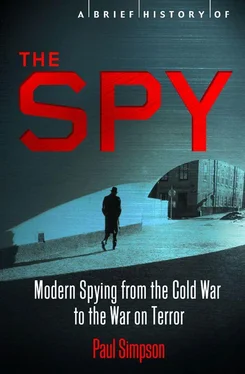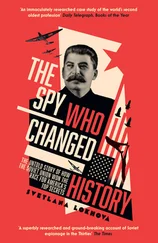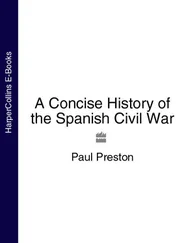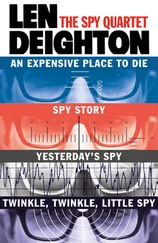Paul Simpson - A Brief History of the Spy
Здесь есть возможность читать онлайн «Paul Simpson - A Brief History of the Spy» весь текст электронной книги совершенно бесплатно (целиком полную версию без сокращений). В некоторых случаях можно слушать аудио, скачать через торрент в формате fb2 и присутствует краткое содержание. Город: London, Год выпуска: 2013, ISBN: 2013, Издательство: Constable & Robinson, Жанр: Прочая документальная литература, на английском языке. Описание произведения, (предисловие) а так же отзывы посетителей доступны на портале библиотеки ЛибКат.
- Название:A Brief History of the Spy
- Автор:
- Издательство:Constable & Robinson
- Жанр:
- Год:2013
- Город:London
- ISBN:9781780338910
- Рейтинг книги:3 / 5. Голосов: 1
-
Избранное:Добавить в избранное
- Отзывы:
-
Ваша оценка:
- 60
- 1
- 2
- 3
- 4
- 5
A Brief History of the Spy: краткое содержание, описание и аннотация
Предлагаем к чтению аннотацию, описание, краткое содержание или предисловие (зависит от того, что написал сам автор книги «A Brief History of the Spy»). Если вы не нашли необходимую информацию о книге — напишите в комментариях, мы постараемся отыскать её.
A Brief History of the Spy — читать онлайн бесплатно полную книгу (весь текст) целиком
Ниже представлен текст книги, разбитый по страницам. Система сохранения места последней прочитанной страницы, позволяет с удобством читать онлайн бесплатно книгу «A Brief History of the Spy», без необходимости каждый раз заново искать на чём Вы остановились. Поставьте закладку, и сможете в любой момент перейти на страницу, на которой закончили чтение.
Интервал:
Закладка:
On Christmas Day 1979 the Soviets invaded Afghanistan, with KGB Alpha Anti-Terrorist assault commandos at their head, disguised as Afghans. In an echo of CIA actions in the sixties, they broadcast radio messages purporting to come from the government, calling for Soviet assistance. This the Soviets duly provided, creating a new regime — and the KGB helped the Afghans to set up a more organized Security Service, the Khedamat-e Etela’at-e Dawltai (KHAD) ‘to protect democratic freedoms… as well as to neutralise… the plots hatched by external enemies of Afghanistan’. In practice this meant the Soviets taught their new pupils the worst excesses of torture.
The KGB had anticipated that the invasion would go like earlier such incursions in Hungary and Czechoslovakia. Like many before — and since — they underestimated the will of the Afghan people. Instead of a quick and easy operation, KGB officers would be bogged down in Afghanistan for the next decade and as a result of the invasion, relations between East and West would hit a new low. Spies on all sides of the Cold War would be affected.
10
THE EMPIRES STRIKE BACK
The first half of the eighties was a time of mounting tension. The Soviet invasion of Afghanistan had led to the US and others boycotting the Moscow Olympics in 1980, and when the former Governor of California Ronald Reagan was voted into the White House later that year, the anti-Soviet rhetoric was dialled up.
In a speech to the National Association of Evangelicals in Orlando, Florida, in March 1983, Reagan made reference to an ‘evil empire… [who] preach the supremacy of the state, declare its omnipotence over individual man and predict its eventual domination of all peoples on the Earth. They are the focus of evil in the modern world.’ The Soviet news agency TASS responded that Reagan ‘can think only in terms of confrontation and bellicose, lunatic anti-communism’. The militaries in both West and East were built up. At the same time as the ‘evil empire’ speech, Reagan authorized the Strategic Defence Initiative (SDI) (commonly known as ‘Star Wars’ after the George Lucas film), which the new Soviet leader Yuri Andropov said ‘put the entire world in jeopardy’.
Politically, the Soviet Union went through major changes. Leonid Brezhnev died in 1982 and was succeeded by KGB Chief Andropov — but he too would die in office, a mere two years later. Konstantin Chernenko, a crony of Brezhnev’s, followed for a short time, then on his death, Mikhail Gorbachev was appointed in March 1985. Although it wasn’t clear to anyone at the time, Gorbachev’s policies would lead to the end of the Cold War.
The stakes were raised for the intelligence agencies on either side of the Iron Curtain, with the CIA changing course once more and increasing the amount of HUMINT (human intelligence) on which they were relying (partly caused by the blows to SIGINT abilities following Ronald Pelton’s defection in 1980). However 1985 would prove to be a watershed in the espionage game, with a series of recruitments and betrayals by both sides.
Ronald Reagan appointed a new DCI when he took office: William J. Casey, who had served as chief of secret intelligence in Europe for the OSS in World War II. He was the president’s campaign manager, and was the first DCI to be given a seat as a fully participating Cabinet member. He and Reagan shared a similar view of the Soviet threat, and as DCI, Casey wanted to strengthen analysis, revive covert actions in the service of foreign policy, strengthen counter-intelligence and security, and improve clandestine espionage operations. The appropriations for the CIA rose by 50 per cent in the first three budgets of the Reagan administration, and Casey presided over a resurgence in HUMINT. He also took the Agency into areas that had been deemed dangerous during the seventies, with support for anti-Communist insurgent organizations in developing countries — leading to the Iran-Contra scandal that would dominate Reagan’s second term of office.
One of the great successes of Casey’s period in charge of the CIA came from Operation CKTAW. This was a wiretap on the communications lines that ran underground between the Soviet Ministry of Defence in Moscow and the Krasnaya Pakhra Nuclear Weapons Research Institute, in the closed city of Troitsk, twenty-three miles from the centre of the capital. Phone, fax and teletype material could all be accessed from the cables.
The cable-laying was spotted by a KH-11 satellite pass in 1976, and over the next two years, CIA agents in Moscow identified a manhole along the Warsaw Boulevard as the best access point. At the same time, scientists from the Agency’s Office of Development and Engineering created a collar that could be placed around the cable to tap the information. By 1979, they were ready to identify which was the best cable to access with the collar, and Office of Technical Services technician Ken Seacrest was sent to Moscow to enter the manhole. This required him to elude any watchers and risk standing thigh-deep in cold water for a couple of hours beneath the manhole as he tested the different cables. Once the line from the Weapons Research Institute was identified, a permanent tap was set up, which operated successfully until the spring of 1985.
This helped to make up for the sources of SIGINT that were betrayed to the Soviets by former NSA operative Ronald Pelton when he walked into the Soviet embassy in Washington in 1980, desperately in need of money to cover his growing debts. As well as giving up details on Operation Ivy Bells, he told them about the Vortex satellites that were intercepting microwave radio-relay systems; the amount of material coming from a joint NSA-CIA listening post in the Moscow embassy, code-named Broadside; and about the seven most highly classified intelligence operations that the NSA were currently working on. He even revealed the existence of fake tree stumps containing electronic bugs which were placed by CIA operatives near Soviet military installations. Worst of all, he gave them details of every Russian cypher machine that the NSA had been able to crack — leading to the Soviets changing their systems.
CKTAW itself was revealed to the Soviets by a former CIA employee, Edward Lee Howard, who had been dismissed from the Agency in May 1983 after failing a polygraph test prior to taking up a new posting in Moscow. Unfortunately, by that stage he was already privy to a considerable amount of information about CIA activities in Russia, including CKTAW — one of the reasons for his firing was that he admitted to cheating during exercises regarding access to the manhole. That summer, he wrote to the Soviet embassy in Switzerland proposing a meeting with a KGB officer to hand over ‘interesting’ information. The KGB turned him down. In October that year, he considered whether to volunteer information directly to the Soviets at the Washington embassy, but ultimately decided against it. He moved to Santa Fe, New Mexico, where he became involved in a major fight and was put on probation for five years. Around the same time, the KGB reconsidered his application, and he was advised to travel to Vienna to meet a handler. Despite a probation prohibition on leaving the States, he went to Europe, where he passed on documents and information on CIA operations in September 1984 and then again in April 1985. Howard was himself betrayed by a defector from East to West, Vitaly Yurchenko that year, but he managed to evade the FBI, fleeing to Moscow, where he died in 2002.
Howard was also responsible for the end of the life of a major CIA asset in Russia, scientist Adolf Tolkachev. In an odd mirror of the career of his betrayer, Tolkachev also tried unsuccessfully to approach the other side’s intelligence agencies before being taken seriously. Describing himself as a ‘dissident at heart’ (to the extent that at one point he discussed with the CIA the possibility of passing some of his salary from the Agency to the dissident movement in Russia), Tolkachev was a systems engineer at the Scientific Research Institute of Radio who had a top-secret clearance and decided to offer his services to the opposition. His first attempt in January 1977 — dropping a letter into an American’s car — failed because by chance he had chosen the head of the CIA station in Moscow, and his offer seemed too good to be true. He tried on three more occasions, but each time he was ignored. That December he passed through a note containing some details on Soviet aircraft; that calling card proved to be effective, and in February 1978 communications were begun. A risky personal meeting between Tolkachev and CIA handler John Guilsher took place on New Year’s Day 1979 and over the next eighteen months, a system was established. Tolkachev was provided with a camera and was able to supply hundreds of rolls of 35mm film to his CIA contacts, sometimes even taking documents home to photograph them when security was less stringent, other times taking the chance of filming them at his office.
Читать дальшеИнтервал:
Закладка:
Похожие книги на «A Brief History of the Spy»
Представляем Вашему вниманию похожие книги на «A Brief History of the Spy» списком для выбора. Мы отобрали схожую по названию и смыслу литературу в надежде предоставить читателям больше вариантов отыскать новые, интересные, ещё непрочитанные произведения.
Обсуждение, отзывы о книге «A Brief History of the Spy» и просто собственные мнения читателей. Оставьте ваши комментарии, напишите, что Вы думаете о произведении, его смысле или главных героях. Укажите что конкретно понравилось, а что нет, и почему Вы так считаете.












